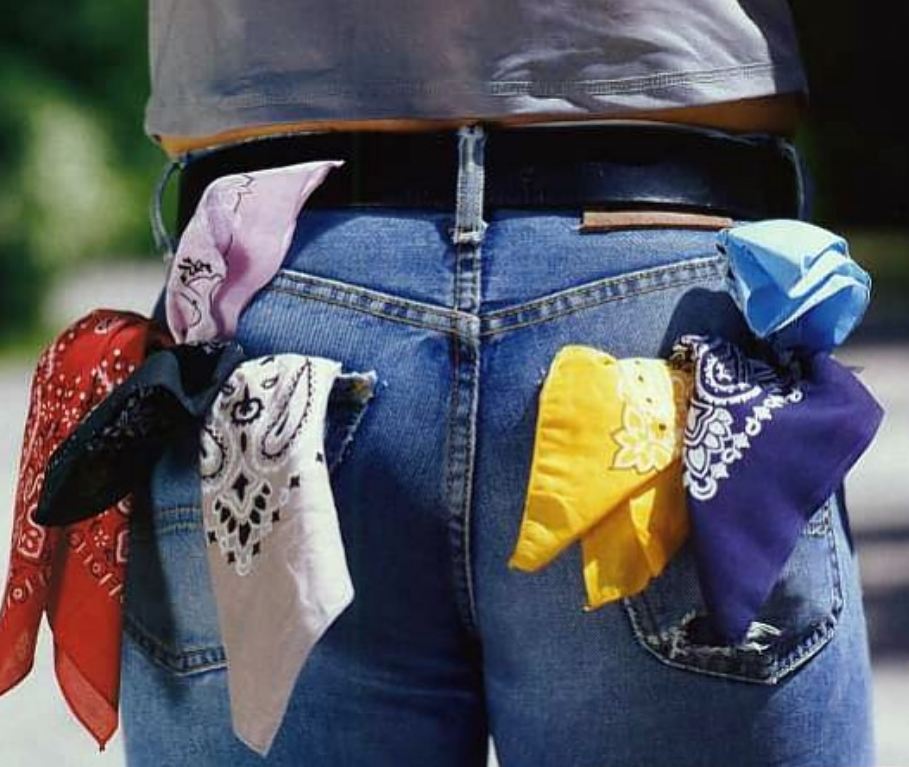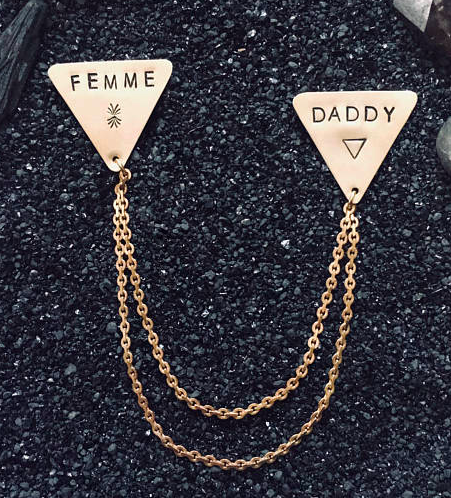
Flagging has long been a part of gay subculture — a way of subtly and safely saying “I’m here and I’m queer” without having to out yourself to the straights. This tactic was especially employed in the old days (not so old days, it was really only like 30 years ago) when it wasn’t as safe to be outwardly queer. While our existence is still “othered” and persecuted in so many ways, we do have more ability to be freely ourselves in public. And thus, flagging has sort of fallen to the wayside.
And while I don’t want to bring back the days of queer people literally fearing for our lives (though #45 is sadly bringing us there), I do want to bring back fashion statements that are solely ours. Ways to indicate to fellow queers that we see them and we are one of them. Clothing can have a way of empowering the wearer — and when said clothing is making an unabashedly queer statement to the world, whether they recognize it or not, it’s a form of embodying invincibility against all odds.
For example, you better bet your sexy ass that my silky green hanky and my bright red bandana aren’t simply for fashion. When I wear these forms of queer expression, I feel more confident, more sexy and more visibly queer. It feels like a form of rebellion against the status quo — mostly because when I catch the eye of someone who picks up on my flagging, I feel like we have a secret language no one else around us knows.
Flagging has an overtly sexual history — often tied to the days of gay men cruising for casual sex in Central Park or leather dykes’ hanging out at their local watering hole. Susan Stryker and Jim Van Buskirk propose in “Gay by the Bay: A History of Queer Culture in the San Francisco Bay Area,” that the hanky code originated in NYC in the 70’s when a journalist for the Village Voice wrote a joke that it would be far more efficient to subtly announce particular sexual prowess with differently colored hankies than wearing keys to indicate whether someone was a top or bottom.
Hanky code was the primary way of flagging back then. Having your hanky on the left side of your body means you’re a top, having it on the right side means you’re a bottom and wearing it around your neck stands for versatile. While the color or pattern are what indicates your particular desires or fetishes — for example, black means you’re into S&M, dark blue stands for anal, red is for fisting and grey means you’re into bondage. This coded and very queer language has been used as a conversation starter, if you will. Wearing a dark blue hanky on your right side doesn’t mean someone come up to you, pull your pants down to start performing anal on you. There are a few basic guidelines when it comes to flagging:
1. Flagging is not consent.
2. Flagging means being cool with being propositioned, being rejected, and having the capacity to reject.
3. Flagging is pan gender (you can’t assume someone’s junk from a flag).
4. There are no anti-flags.
5. Flagging is slut pride.

“The handkerchief is of course an item seen to be especially pertinent amongst the wealthy, upper class, and generally fancy straight men of the time that sought out and courted women with marriage proposals being the ultimate goal of the relationship, not stranger sex,” writes blogger Soul Train Kevin. “Gay men instead turned this snobbish interpretation of the handkerchief around and flipped its meaning and use by literally using it as a signal to any and all comers that careless, almost anonymous sex was available to them should they match up in preferences.”
There’s this term “homosocialization” and honestly, I love this term so much. Us queers have found some incredibly creative ways to communicate to one another without having to out ourselves in potentially dangerous environments. Finding queer community is often a pivotal moment for people just coming into their sexuality or gender identity or navigating a new city/space. There’s something to be said for the ways in which being marginalized brings people together, at times out of necessity and sometimes because we need to commiserate with people who *get it*. Flagging is a way of homosocializing that has given queer folx the ability to talk about our sex without shame — at times when all of society has seen our sex as a literal crime. While some queers who are also immersed in kinky or BDSM communities still use the hanky code, it’s not as widely recognized anymore.
Other forms of flagging have since been taken over by straights altogether, too. Do you remember that phase every straight girl went through 5 years ago with painting her fourth nail a different color than the rest? Yup, that started off as a queer femme flagging tactic. But the straights coopted it and thus made it meaningless.
So queer babes, it’s time to bring back flagging for everyone to recognize and use more regularly. Here are 3 ways I’m proposing we can do it!
1. Literally start flagging again, hanky code and all.
This summer, I want to see y’all out and about with your hanky’s! Tuck them into your high waisted shorts. Wrap them around your bikini top. Boldly tie them around your neck. Wear them to brunch. Wear them to Cubbyhole. Bring them to the next queer play party.
It’s important that if you see someone else flagging and want to go flirt with them, that you know consent is still absolutely vital. Ask them about their hanky, what it means to them, if you can grab their number, etc. You get the picture.
For full hanky code of colors, positions and patterns click here.
2. Reclaim femme nail polish flagging.
Queer femmes are pure magic. I love the ways in which we exist in the world — the radical ways in which we take up space and create new ways to express our femmeness constantly. When people tell us that we can’t f*ck with our long nails, we inform them otherwise. When people tell us we’re too pretty to be queer, we show them otherwise.
And when we’re told to take up less space in queer spaces, we find ways to create space for our own nuanced experiences. Like femme nail polish flagging. It started to be a thing around 2007 when queer femmes on Tumblr started to dictate what certain patterns, colors and designs represented sexually.

“Moira, sitting on the edge of my bed, legs crossed, ankle on knee, in her purple overalls, one dangly earring, the gold fingernail she wore to be eccentric, a cigarette between her stubby yellow-ended fingers,” writes Marget Atwood in “The Handmaid’s Tale” which could be said to be a subtle prediction for femme flagging back in 1985.
However, in 2012 popular publications like Jezebel and xoJane started to write pieces about this queer femme practice — and thus, straight women turned it into “accent nails.”
“I’m worried that accent nails are too popular now to be used as a way to flag femme and/or queer. Pinterest is full of accent nail pictures, especially the ring finger, and I have seen lots of straight women wearing accent nails now too. So was anything ever decided on a definitive color or nail to at least flag queer?” wrote Tumblr user invertsugar on May 7, 2012.
But I vote that we find new ways to flag with our nail polish. Maybe we make it about not painting certain nails to flag different desires. Or we have different designs to code for our kinks — like stripes for bondage and polka dots for fisting or silver glitter on only the pinky nail for femme4femme desires. Who wants to write the code with me and disperse across the queer internet?! Hit me up.
3. Use pins to flag.
Pins are a new feminist fashion statement that has taken our culture by storm. While this form of flagging is definitely a little bit more overt than hanky or nail polish code — it might just work now that we have the ability to be more visible. If you’re into fisting, it’s simple, just wear this pin on the lapel of your leather jacket.

Are you a sexy femme daddy? Get this collar chain for yourself and you might just find the baby you’re looking for ;). I guess that with the convenience of visibility, we get the opportunity to be more out with our desires. And let’s be real, most of the messages on these pins will go right over the heads of clueless straight folx, bless their hearts.
While flagging might seem like a simple fashion statement to some, it can be a nuanced tool for queer communication and connection for others. A baby queer in rural America might just see an older dyke wearing a red bandana around her neck and feel so affirmed in that moment. It’s vital to learn about the history of homosocializing and also find ways to continue it — because, honestly, f*ck normalcy. I don’t want to be normal. I don’t want queerness to be normalized. I want to be queer AF and I want my fellow queers to know it and to see me.

What Do You Think?